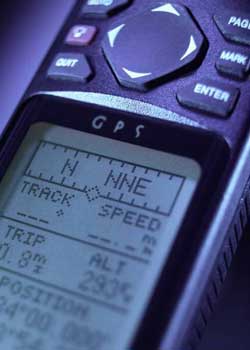Geocaching is a high-tech game of hide and seek. For some it is a fun and challenging hobby; for others it is an addiction. Geocaching (pronounced GEE-oh-cashing) is like Letterboxing in that your goal is to find a box concealed in a secret location on public land. To play, you use a handheld navigation device called a Global Positioning System (GPS) receiver. Geocaching is a great way to learn how to use GPS.
 |
Geocaching is a high-tech game of hide and seek that uses a GPS receiver to hunt for a box filled with treasure. |
Geocaching was born in 2000, when the U.S. Dept. of Defense stopped degrading global positioning signals, making civilian GPS receivers much more accurate. A few days later, a computer consultant hid a treasure-filled bucket in the Oregon woods and then posted the coordinates on the Internet. Since then, individuals and organizations have set up more than 436,067 caches around the world. Some require difficult hiking or orienteering; others are hidden in cities inside or outside of buildings.
Finding the cache is the challenge. You might think it would be easy because you know the latitude and longitude. But the GPS unit shows distance as the crow flies, and the trail may have many twists and turns. Also, the coordinates will only get you within 6 to 20 feet of the geocache. You must also rely on clues, some of which have to be deciphered, to find the actual stash.
The fun part is exploring different locations, and discovering what lies inside the “cache.” The small waterproof container holds a logbook and some goodies. (Micro-caches are too small for anything but a logbook.) The logbook might contain information about nearby attractions, coordinates to other unpublished caches, or other fun tidbits. When you find the cache, you take one goodie and leave another of equal or greater value, and log into the book.
I gave geocaching a whirl while in Washington State with a friend who had a GPS unit. The search led us to a lovely winery (where of course we had to sample their products), a scenic park I never knew existed even though I lived out there for three years, and a farm. It was fascinating to see what kinds of treats had been left in the box. My favorite find was a homemade video of a typical weekend in a small town. Other “prizes” might be small toys (called “swags”) or trinkets, maps, books, CDs, pictures, money, jewelry, tools or games. (Obviously no one should place explosives, ammo, drugs, knives, alcohol or food in a cache.) Some caches contain an item called a “travel bug” or “geocoin.” It has a number on it so people can log and track its travels online.
For gear, you will need a GPS unit. They cost between $100-1000, depending on their capabilities. The Garmin eTrex is the least expensive, is fairly easy to use, and will get you within 20 feet of any geocache. The next level up has a built in electronic compass, topographic maps, more memory, etc. You should also bring along a daypack with a printout of cache clues from the Internet, extra batteries, a map, a cell phone, a compass if your GPS unit does not have one, water, snacks, and a pencil or waterproof pen. Be aware of your surroundings – while concentrating on your GPS readout, you don’t want to fall in a hole or walk off a cliff.
You might also bring a plastic bag to “Cache In Trash Out.” In the spirit of giving thanks for allowing geocachers on parks and other property, participants often collect litter for proper disposal. Make sure to seal the cache and hide it back where you found it, to prevent it from being “muggled" (ala Harry Potter, a Muggle is a non-geocacher who steals or vandalizes a cache).
Start at www.geocaching.com to find a list of geocaches near you or a location you plan to visit. More than 725 geocaches are hidden within 25 miles of Woodstock. After several trips to geocaches in your area, you’ll ready to hide your own.
| Practice common courtesy, and ALWAYS ask for permission before placing a new letterbox or geocache. Either could have an unintended negative impact on sensitive habitats and natural or cultural resources. It is actually illegal to place a cache on National Park Service land without first obtaining permission. In a post-9/11 world, the lids of letterboxes and geocaches should always be labelled as such. Help make letterboxing and geocaching an educational and entertaining experience, while preserving our environment for future generations of explorers. |
|

